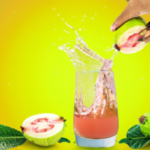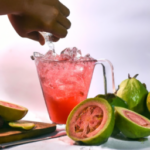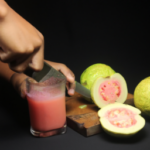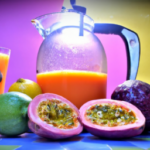Juice Tips and Tricks
How To Make Guava Juice

I get where you’re coming from – why bother making guava juice myself when I can just buy it?
But hear me out. Making your own guava juice is not only easy, but it also ensures that you’re getting the freshest, most nutritious juice possible. Plus, it’s a fun and satisfying way to experiment with different flavors and textures.
Not to mention, guava is a superfood that offers numerous health benefits. It’s rich in vitamin C, fiber, and antioxidants, which can boost your immune system, aid in digestion, and protect against chronic diseases.
So, if you’re ready to try your hand at making your own guava juice, keep reading for a step-by-step guide on how to do it.
Key Takeaways
- Guava is a superfood that is rich in vitamin C, fiber, and antioxidants.
- When picking guavas, look for ripe ones that are soft and fragrant.
- To prepare guavas for juicing, wash them, cut off the top and bottom, scoop out the seeds, and slice them into small pieces.
- To sweeten and adjust the consistency of guava juice, add sweetener and water to taste, and consider adding other fruits to enhance the flavor and add nutrients.
Health Benefits of Guava
You’re going to love how guava juice not only tastes amazing, but is also packed with health benefits. Guavas are known for their high nutritional value and medicinal properties. They contain high amounts of vitamin C, which helps in fighting infections and building a stronger immune system.
Guavas are also rich in fiber, which aids in digestion and prevents constipation. Moreover, guavas have antioxidants that protect your body from damage caused by free radicals. To make delicious guava juice, the first step is to gather fresh guavas.
Look for guavas that are ripe, but not too soft to the touch. The skin of the guava should be smooth and free from any blemishes or bruises. Once you have gathered fresh guavas, the next step is to wash them thoroughly under running water.
Now that you have the fresh guavas ready, it’s time to start making the juice!
Gather Fresh Guavas
After scouting the local markets, it’s best to handpick fresh guavas as it guarantees the quality and ripeness of the fruit. When picking guavas, it’s important to look for fruits that are slightly soft to the touch and have a fragrant aroma. Avoid guavas that have blemishes, bruises, or are too hard as they may not be ripe yet.
To ensure that the guavas stay fresh, it’s essential to store them properly. Guavas can be stored at room temperature for up to a week or in the refrigerator for up to two weeks. If the guavas are not ripe yet, they can be stored in a paper bag at room temperature to speed up the ripening process. Proper picking and storage techniques are important in making sure that the guavas are of the highest quality and are ready to be used in making delicious guava juice. Moving on to the next step, let’s learn how to wash and cut the fruit.
Wash and Cut the Fruit
Now that you’ve got your hands on some ripe guavas, it’s time to give them a good wash and slice them up into perfect little pieces of tropical goodness, so you can start sipping on a refreshing glass of guava nectar.
When it comes to washing the fruit, I like to use a gentle scrub brush to remove any dirt or debris on the skin. Once the guavas are nice and clean, it’s time to start cutting.
The cutting technique for guavas can be a bit tricky if you’ve never done it before. It’s important to first cut off the top and bottom of the fruit, so you have a stable base to work with. Then, using a sharp knife, carefully slice the guava in half lengthwise. From there, you can scoop out the seeds and slice the fruit into small pieces.
Juicing tips: I find that using a juicer or blender works best to get the most juice out of the guavas. And don’t forget to save those seeds for the upcoming section on how to remove them!
Remove the Seeds
To efficiently extract the seeds from the guava, it’s crucial to use a strainer or sieve to separate them from the pulp. This step is important to ensure that your guava juice is smooth and seedless.
There are a few tips and tricks to make this process easier. Firstly, cut the guava in half and scoop out the seeds with a teaspoon. You can also use a small knife to cut the seed pockets out. Once you have removed all the seeds, put the pulp into a strainer or sieve and press it through with a spoon or spatula.
Make sure to scrape the bottom of the strainer to get all the juice out. If you’re using a sieve, you can use the back of a spoon to press the pulp through. With these tips, you’ll have seedless guava juice in no time!
Now that we have removed the seeds from the guava, it’s time to move on to the next step: blending or juicing. By removing the seeds, we have ensured that our guava juice will be smooth and easy to drink. Let’s get started!
Blend or Juice the Guava
So now that we’ve removed the seeds, it’s time to blend or juice the guava. Personally, I prefer using a blender as it allows me to get a smoother consistency. However, if you have a juicer, that works great too!
Let’s dive into these two methods and see which one works best for you.
Using a Blender
Using a blender is the easiest way to make guava juice at home. It’s a simple process that requires just a few ingredients and equipment. Here are the steps to make guava juice using a blender:
-
Choose ripe guavas: The best time to harvest guavas for juicing is when they’re fully mature and ripe. Look for guavas that are soft to the touch and have a sweet aroma.
-
Cut and blend: Wash the guavas and cut them into small pieces. Add the pieces to a blender and blend until smooth.
-
Strain the mixture: Pour the blended mixture through a fine mesh strainer to remove any seeds or pulp.
-
Add sweetener and water: Taste the juice and add sweetener if needed. You can use honey, sugar, or any other sweetener of your choice. Add water to adjust the consistency of the juice.
If you don’t have a blender, you can also use a juicer to make guava juice. However, using a blender is more convenient and requires less cleanup.
In the next section, I’ll explain how to make guava juice using a juicer.
Using a Juicer
Get ready to experience the full flavor of ripe, sweet guavas with the help of a juicer. Using a juicer is an easy and effective way to make guava juice. Before starting, make sure your juicer is clean and well-maintained. This will ensure that your guava juice is free of any unwanted particles and tastes fresh.
When using a juicer, there are a few alternative methods to consider. You can either remove the seeds from the guavas before juicing or leave them in. Leaving the seeds in will give your juice a slightly bitter taste, but they’re also a good source of fiber. Alternatively, you can add some water to the juicer to dilute the juice and make it less thick.
Once you’ve extracted the juice, you can move on to the next step of adding sugar or sweetener (optional).
Add Sugar or Sweetener (Optional)
You can choose to add a pinch of powdered sugar or a spoonful of honey as a sweetener to enhance the guava’s natural flavor. Adding sugar or a sweetener to your guava juice has its pros and cons.
On one hand, adding sugar enhances the taste of the juice and makes it more enjoyable. On the other hand, consuming too much sugar has negative health effects such as weight gain and increased risk of diabetes.
If you decide to add a sweetener to your guava juice, you can choose from various options such as honey, agave syrup, or maple syrup. Honey is a great choice as it complements the guava’s taste and is known for its antibacterial properties. Agave syrup is another option that is lower in glycemic index and has a milder taste than honey. Lastly, maple syrup is a great choice if you prefer a more earthy and nutty flavor.
To add sweetness to your guava juice, you can mix in the sugar or sweetener of your choice. Start by pouring a small amount and taste the juice before adding more. Remember that the guava fruit is already naturally sweet, so you don’t want to overpower its flavor with too much added sugar or sweetener.
Once you’ve added the desired amount, mix the juice well to ensure that the sugar or sweetener is evenly distributed. With a sweet and tasty guava juice in hand, you can now move on to the next step of adding water or other fruits (optional).
Add Water or Other Fruits (Optional)
Now that I’ve added sugar to my guava juice, I can move on to the next step. The key here is to choose the right liquid to dilute the juice, as this will affect the overall taste and texture. Additionally, adding other fruits can enhance the flavor and add extra nutrients to the drink.
Let’s explore these options further and create a truly delicious and refreshing guava juice.
Choosing the Right Liquid
Firstly, when it comes to choosing the right liquid for your guava juice, there are a few tips to keep in mind. It’s important to select a liquid that will complement the sweet and tangy flavor of guava, while also enhancing its natural texture.
Here are some options to consider:
-
Water: Adding water to your guava juice will dilute the flavor slightly, but it can also help to balance out any sweetness and create a lighter, more refreshing beverage.
-
Coconut water: For a tropical twist on guava juice, try using coconut water as your liquid base. This will add a subtle coconut flavor and provide some extra hydration benefits.
-
Pineapple juice: Another fruit juice that pairs well with guava is pineapple juice. This will add a sweet and tangy flavor that complements the guava perfectly.
When you have selected the best liquid for your guava juice, it’s time to move on to the next step: adding other fruits for flavor. By experimenting with different fruit combinations, you can create a unique and delicious guava juice that is perfect for any occasion.
Adding Other Fruits for Flavor
To really take your guava juice to the next level, why not mix in some other fruits to create a flavor explosion that’ll tantalize your taste buds and leave you feeling refreshed and rejuvenated?
One of my favorite mixing techniques is to blend in some strawberries and bananas. The sweetness of the strawberries perfectly complements the tanginess of the guava, while the creaminess of the bananas gives the juice a smooth and velvety texture.
Another great taste combination is to add in some pineapple and mango. The tropical flavors of these fruits add a delicious twist to the guava juice, transporting you straight to a sunny beach paradise.
When experimenting with different fruits, be sure to find the right balance of flavors and adjust the amount of each fruit accordingly. Now that we’ve added some extra fruits, it’s time to strain the juice (optional) to remove any pulp or seeds for a smoother consistency.
Strain the Juice (Optional)
If you prefer a smoother texture, you can strain the guava pulp using a fine mesh strainer or cheesecloth. Straining the juice removes any remaining seeds, pulp, or fibers, resulting in a smoother and more refined juice. However, some people prefer the added texture and fiber that comes with unstrained juice.
To strain or not to strain: pros and cons. Straining the juice can be time-consuming and messy, but it can also be worth it for those who prefer a smoother texture. There are different ways to strain juice, such as using a fine mesh strainer or cheesecloth. Ultimately, it comes down to personal preference and whether you value a smoother texture over added fiber.
Now that we’ve covered straining, let’s move on to the final step of chilling and serving the guava juice.
Chill and Serve
You wouldn’t want to skip the final step of enjoying your perfectly chilled and served guava juice, now would you? After all the hard work of preparing the fruit, extracting the juice, and possibly straining it, it’s time to sit back and enjoy the refreshing drink. But before you do, why not get a little creative with your serving methods? Guava juice can be enjoyed in a variety of ways, whether it’s adding a splash to your morning smoothie or mixing it up into a fun cocktail for happy hour.
To get your creative serving juices flowing, here’s a table with some guava cocktail recipes to try out:
| Guava Cocktail Recipes | Ingredients |
|---|---|
| Guava Margarita | Tequila, lime juice, guava nectar, triple sec, salt |
| Guava Cosmo | Vodka, guava nectar, lime juice, cranberry juice |
| Guava Mojito | White rum, fresh mint leaves, lime juice, guava nectar, club soda |
Once you’ve decided on your preferred serving method, it’s time to chill your guava juice. This can be done by placing it in the refrigerator for at least an hour before serving. And there you have it, your very own homemade guava juice! Enjoy it as is or get creative with your serving methods, but most importantly, savor the delicious taste of your hard-earned creation.
Enjoy Your Homemade Guava Juice!
Indulge in the satisfying taste of your homemade guava juice and explore creative serving methods to enhance your experience. After all the hard work you’ve put into making your juice, it’s time to sit back, relax, and enjoy the fruits of your labor.
But don’t settle for a plain glass of guava juice. Why not try some alternative recipes and serving suggestions to make the experience even more enjoyable? One fun way to serve guava juice is to mix it with sparkling water or soda for a refreshing and bubbly drink. You can also try adding a splash of coconut milk or almond milk for a creamier texture.
If you’re feeling adventurous, you can even experiment with adding other fruits or herbs to your guava juice, such as mint, lime, or pineapple. The possibilities are endless, so don’t be afraid to get creative and find a combination that suits your tastes.
Frequently Asked Questions
What is the recommended daily intake of guava juice for optimal health benefits?
To get the most out of guava juice, I recommend drinking it as a post-workout drink. It’s also great for weight loss. As the saying goes, "an apple a day keeps the doctor away,"but a glass of guava juice may be even better.
Can guava juice be stored for an extended period of time, and if so, what is the best way to store it?
Yes, guava juice can be stored for an extended period of time using preservation techniques. To ensure long term storage, it’s best to store it in an airtight container in the refrigerator or freezer.
Are there any potential side effects or risks associated with consuming guava juice?
Oh sure, because everything we consume nowadays is completely risk-free. But fear not, the potential risks of guava juice are minimal compared to its numerous benefits. It’s a great source of Vitamin C, fiber, and antioxidants.
How does the nutritional content of guava juice compare to other fruit juices?
I’ve conducted a comparative analysis of fruit juices and found that guava juice is a nutritional powerhouse. It has higher levels of vitamin C and antioxidants than most other fruit juices, making it an excellent choice for its health benefits.
Are there any creative recipes or variations of guava juice that can be made using different ingredients or methods?
I love experimenting with guava juice by creating creative variations and mixing flavors. Adding a splash of lime juice or blending it with strawberries and bananas can elevate the taste. The possibilities are endless!
Conclusion
Phew, that was quite the process! But now, holding a tall glass of homemade guava juice, I can confidently say that it was all worth it.
Not only is guava a delicious fruit, but it also packs a punch in terms of health benefits. Did you know that one guava fruit contains four times the amount of vitamin C as an orange? That’s right, just one guava can provide over 200% of your daily recommended intake of this essential nutrient!
Drinking guava juice not only helps boost your immune system, but it can also aid in digestion, regulate blood sugar levels, and even improve heart health. So not only are you treating your taste buds, but you’re also treating your body to some much-needed nutrients.
Next time you’re in the mood for a refreshing drink, skip the store-bought options and try making your own guava juice. It may take a bit of effort, but the end result is well worth it.
And who knows, you may even impress your friends and family with your juicing skills and newfound knowledge on the benefits of guava.
Cindy thoroughly researches juicing trends, techniques, and recipes to provide readers with practical advice and inspiration. Her writing style is accessible, engaging, and designed to make complex concepts easy to understand. Cindy’s dedication to promoting the advantages of juicing shines through her work, empowering readers to make positive changes in their lives through the simple act of juicing.
Juice Tips and Tricks
How to Make Aloe Vera Juice Taste Better

Tired of the strong flavor of aloe vera juice? No problem, we’ve got the answer for you.
In this article, we’ll share some tips and tricks to make your aloe vera juice taste better. We have tried and tested various methods to enhance the flavor without compromising the health benefits.
From choosing the right juice to adding natural sweeteners and infusing with fruits and herbs, we’ve got all the information you need to transform your aloe vera juice into a delightful and refreshing beverage.
Let’s dive in!
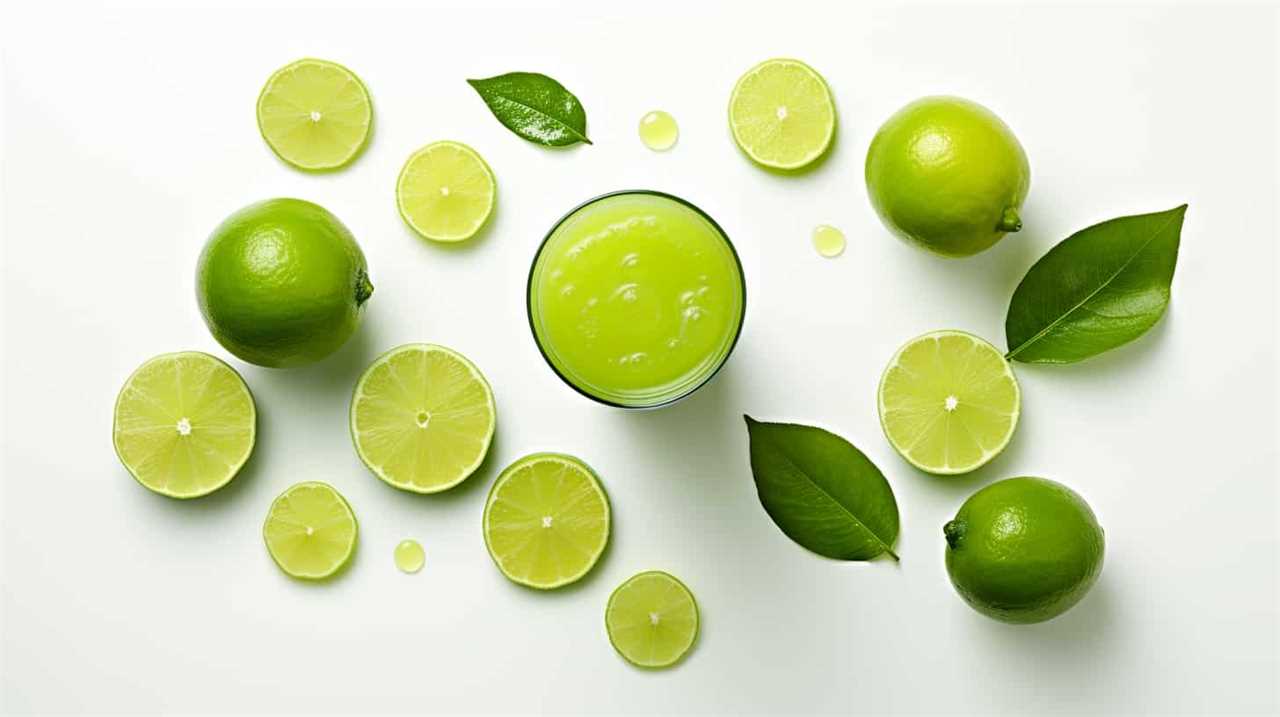
Key Takeaways
- Choose a reputable brand of aloe vera juice that prioritizes quality and uses organic, pure aloe vera.
- Avoid brands that contain added sugars or artificial ingredients.
- Use natural sweeteners like honey, agave syrup, or stevia to enhance the taste of aloe vera juice.
- Experiment with adding fruits, herbs, and other juices to create unique flavor combinations and enhance the health benefits of aloe vera juice.
Choosing the Right Aloe Vera Juice
We can enhance our experience with aloe vera juice by selecting the right brand and type for our preferences. When it comes to finding a reputable brand, it’s important to do some research and read reviews from other consumers. Look for brands that prioritize quality and use organic, pure aloe vera without any added sugars or artificial ingredients. Understanding the health benefits of aloe vera juice is also crucial in making the right choice. Aloe vera is known for its soothing properties, aiding digestion, promoting skin health, and boosting the immune system. By choosing a high-quality brand, we can ensure that we’re getting the maximum benefits from our aloe vera juice.
Now that we know how to choose the right brand, let’s move on to the next step of adding natural sweeteners.
Adding Natural Sweeteners
To enhance the flavor of our aloe vera juice, we can add natural sweeteners such as honey or agave syrup. Using alternative sweeteners not only adds sweetness but also brings unique flavors to the juice. Here are some options to consider:
- Stevia: A natural sweetener derived from the Stevia plant, it’s a zero-calorie alternative to sugar.
- Maple Syrup: This natural sweetener adds a rich and earthy flavor to the aloe vera juice.
- Dates: Pureed dates can be used to sweeten the juice while also providing essential nutrients like fiber.
In addition to using alternative sweeteners, we can enhance the flavor of aloe vera juice by adding spices and extracts. Cinnamon, ginger, or vanilla extract can add warmth and depth to the taste. By experimenting with different combinations of these natural sweeteners, spices, and extracts, we can create a flavor profile that suits our preferences.
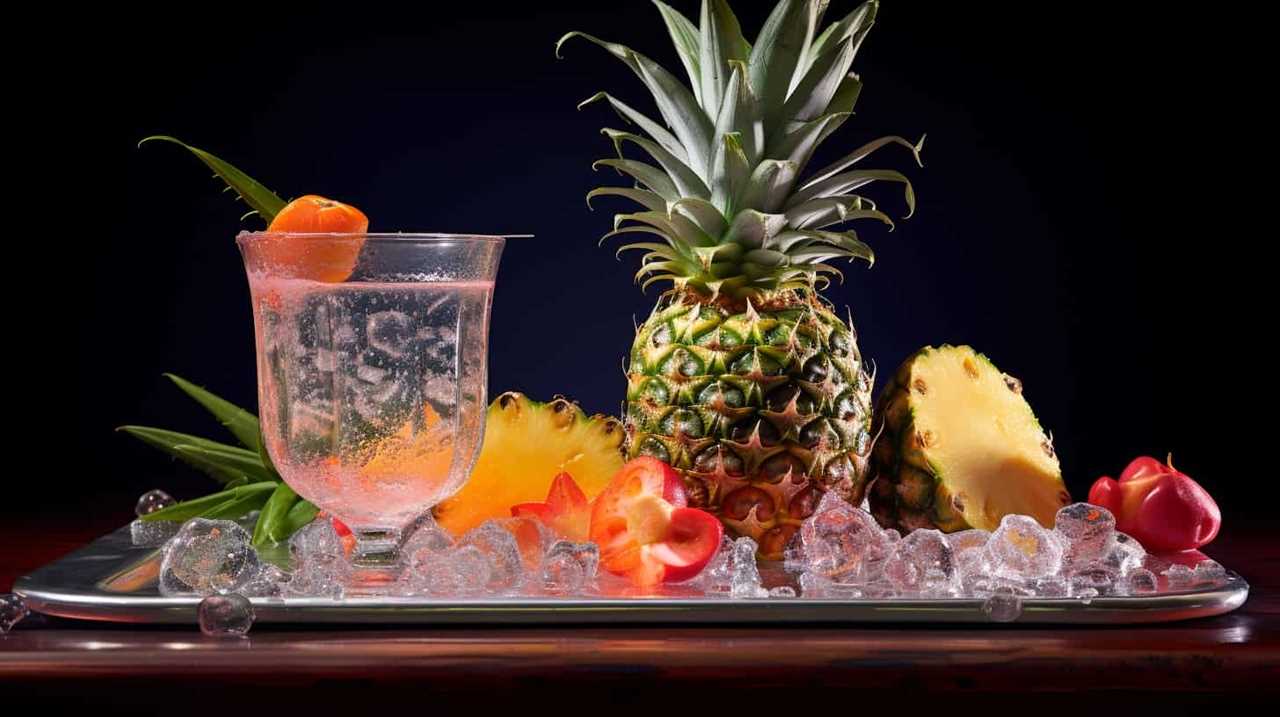
Now, let’s move on to the next section and learn how to infuse aloe vera juice with fruits and herbs to further enhance its taste.
Infusing With Fruits and Herbs
As we explore ways to make our aloe vera juice taste better, one option to consider is infusing it with fruits and herbs. Creating unique aloe vera blends by adding fruits and herbs not only enhances the flavor but also adds a touch of freshness and complexity to the juice.
Fruits like strawberries, pineapple, or citrus can add a burst of sweetness, while herbs like mint, basil, or ginger can provide a subtle yet refreshing twist. Exploring the benefits of herbal infusions can also be beneficial for our health. For example, adding a few sprigs of lavender can promote relaxation and reduce stress. Additionally, infusing aloe vera juice with rosemary can aid digestion and boost the immune system.
Blending With Other Juices
Let’s try mixing aloe vera juice with different fruit juices to create delicious and refreshing blends. Blending aloe vera juice with other fruits not only enhances its taste but also adds nutritional benefits to your drink. Here are three fruit juices that you can mix with aloe vera juice:

- Orange juice: Combining aloe vera juice with orange juice not only adds a tangy flavor but also boosts your intake of vitamin C, which is essential for a strong immune system.
- Pineapple juice: Mixing aloe vera juice with pineapple juice creates a tropical blend that isn’t only refreshing but also helps in digestion. Pineapple contains bromelain, an enzyme that aids in breaking down proteins and promoting better digestion.
- Watermelon juice: Blending aloe vera juice with watermelon juice creates a hydrating and refreshing combination. Watermelon is rich in water content and contains electrolytes that can help replenish your body’s fluids.
Experimenting With Flavor Combinations
While we can try various flavor combinations with aloe vera juice, it’s important to find the right balance to enhance its taste. Experimenting with different flavors can’t only make the juice more enjoyable but also enhance its health benefits.
Aloe vera juice is known for its numerous health benefits, such as boosting digestion, promoting hydration, and supporting the immune system. By adding complementary flavors, we can create a refreshing summer drink that not only tastes great but also provides a nutritional boost.
Some popular flavor combinations include mixing aloe vera juice with citrus fruits like lemon or orange, adding a splash of coconut water for a tropical twist, or combining it with cucumber and mint for a refreshing and cooling effect.
Don’t be afraid to get creative and find the flavor combination that suits your taste buds best!
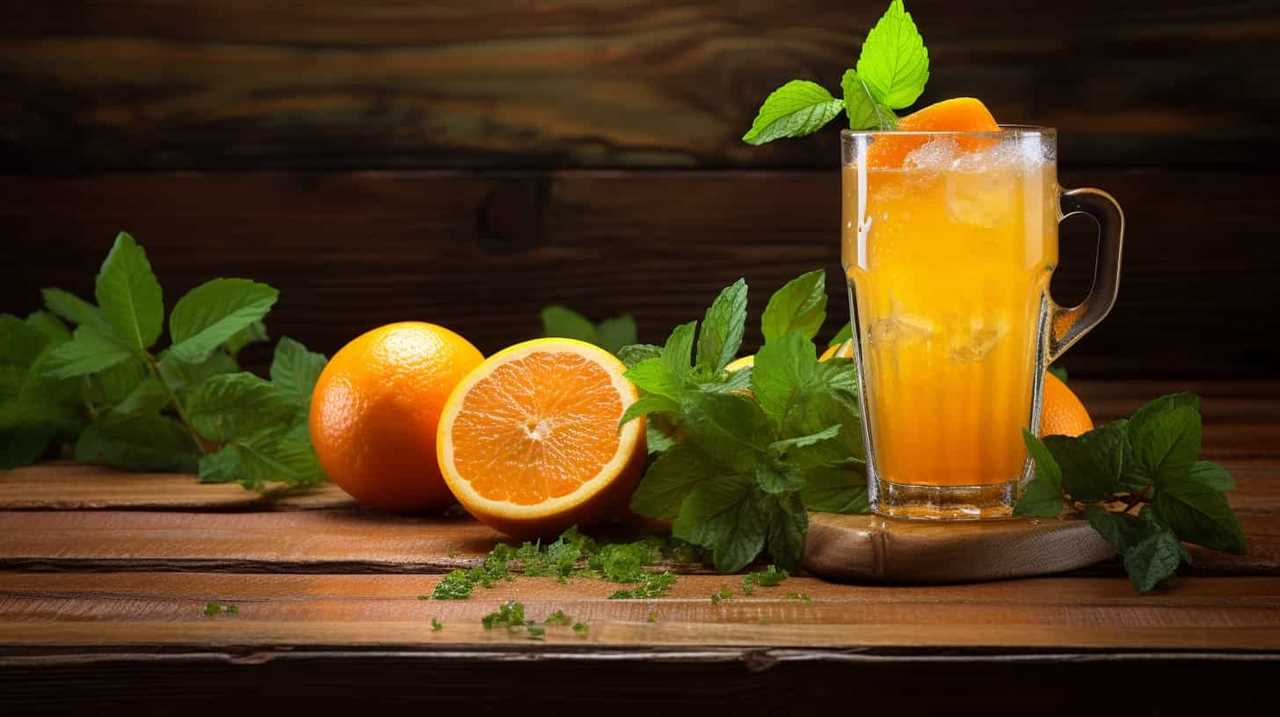
Frequently Asked Questions
Can I Use Store-Bought Aloe Vera Gel Instead of Fresh Aloe Vera for Making Juice?
Yes, you can use store-bought aloe vera gel instead of fresh aloe vera for making juice. However, it’s important to note that fresh aloe vera juice may have more health benefits due to its higher nutrient content.
How Long Can I Store Aloe Vera Juice in the Refrigerator?
Aloe vera juice can be stored in the refrigerator for up to a week. Refrigeration helps maintain the longevity and freshness of the juice, preserving its beneficial properties.
Can Aloe Vera Juice Help With Digestive Issues?
Aloe vera juice can potentially help with digestive issues when taken in appropriate dosages. However, it is important to note that there may be potential side effects. It is always best to consult with a healthcare professional before starting any new supplement regimen.
Can I Use Artificial Sweeteners Instead of Natural Sweeteners in My Aloe Vera Juice?
Using artificial sweeteners in aloe vera juice may affect its taste and potential health benefits. However, natural sweeteners like honey or stevia can enhance the flavor without compromising its nutritional value.

Is It Safe to Drink Aloe Vera Juice Every Day?
Drinking aloe vera juice daily can have numerous benefits, such as improving digestion and boosting the immune system. However, consuming it regularly may also lead to potential side effects like diarrhea or stomach cramps.
Conclusion
In conclusion, making aloe vera juice taste better is easy and enjoyable.
By choosing the right aloe vera juice and adding natural sweeteners, infusing with fruits and herbs, blending with other juices, and experimenting with flavor combinations, you can create a delightful and refreshing drink.
So go ahead and unleash your creativity in the kitchen, and transform your aloe vera juice into a sensational elixir that will transport your taste buds to paradise.
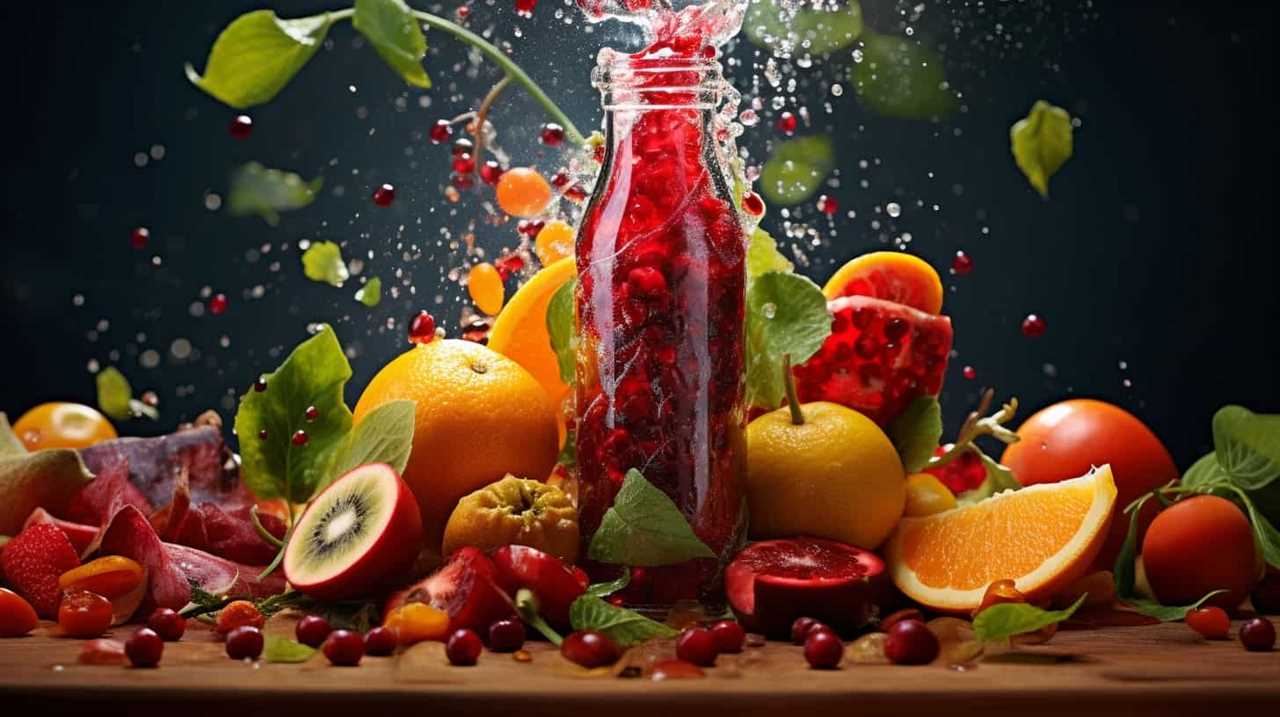
Susannah expertise lies in researching and compiling evidence-based content on juicing, nutrition, and overall health. She is committed to ensuring that The Juicery World offers accurate, up-to-date, and trustworthy information to empower readers to take control of their health. Susannah’s goal is to inspire individuals to embrace juicing as a way to nourish their bodies and live their best lives.
Juice Tips and Tricks
How to Make a Glass of Lemonade With Bottled Lemon Juice

Are you craving a cool glass of lemonade to quench your thirst? Look no further! Try out our perfect recipe using bottled lemon juice that will surely please your taste buds.
In this article, we’ll guide you through the process of creating a tangy and sweet concoction that will leave you feeling refreshed and satisfied.
So grab your ingredients and let’s get started on this delightful journey of serving ourselves and others a glass of pure lemony goodness.
Key Takeaways
- Consider the storage of the bottled lemon juice (dark glass or plastic bottles, protect from light exposure, check expiration date)
- Choose a suitable pitcher and fresh lemons for enhanced flavor
- Store the lemonade concentrate in the refrigerator to maintain freshness
- Adjust the sweetness and tartness to taste with sugar or more lemon juice, and experiment with different sweeteners or additional flavors.
Choosing the Right Bottled Lemon Juice
What are the key factors we should consider when selecting the right bottled lemon juice for our lemonade?

One important factor is how the lemon juice is stored. Look for bottles that are made of dark glass or plastic, as they help protect the juice from light exposure, which can degrade its quality. It’s also important to check the expiration date to ensure freshness.
Another benefit of using bottled lemon juice is convenience. It saves time and effort compared to squeezing fresh lemons. Additionally, bottled lemon juice provides consistent flavor, as the acidity levels are standardized.
When selecting a brand, consider reading reviews and checking for certifications, such as organic or non-GMO.
Gathering the Necessary Ingredients and Tools
How can we gather all the necessary ingredients and tools to make a glass of lemonade with bottled lemon juice?
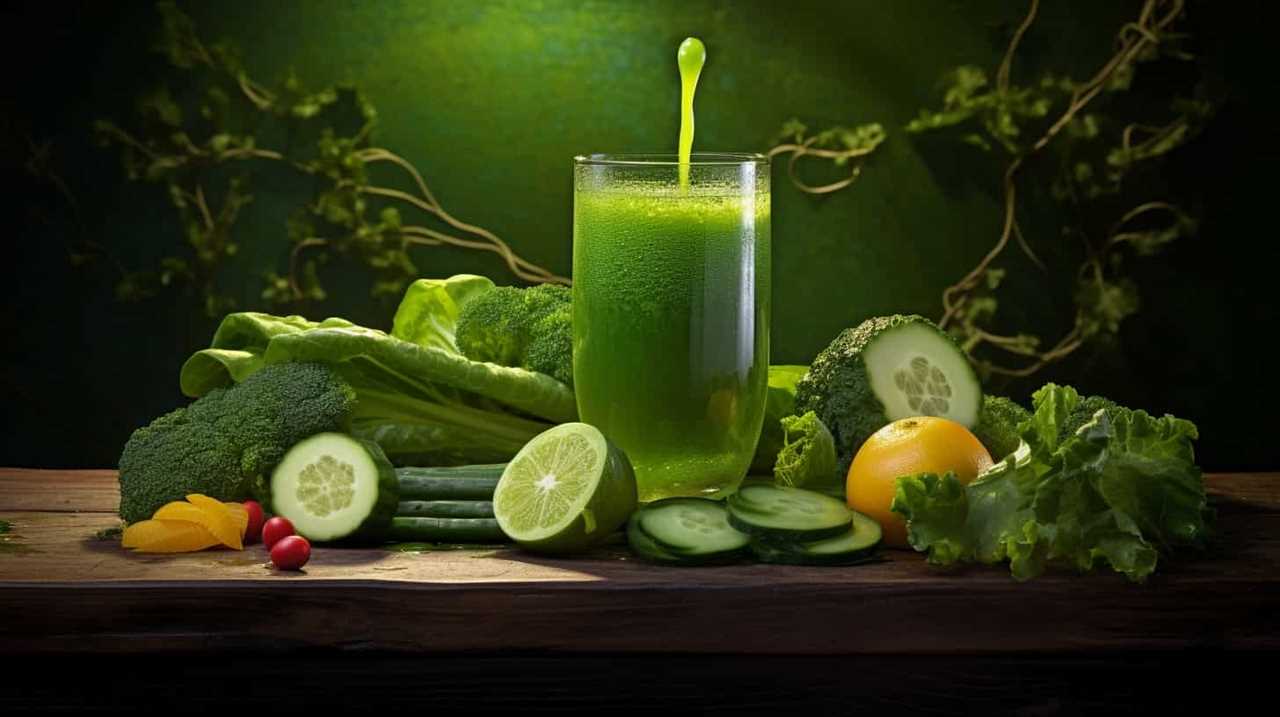
It’s important to start with the right pitcher. Look for a pitcher that’s made of glass or BPA-free plastic, as these materials won’t affect the taste of the lemonade. The pitcher should also have a lid or cover to keep the lemonade fresh and prevent spills.
Now, let’s talk about the lemons. While bottled lemon juice is convenient, using fresh lemons instead can elevate the flavor of your lemonade. Choose lemons that are firm and have a bright yellow color. Give them a gentle squeeze to ensure they’re juicy. To extract the juice, you’ll need a citrus juicer or a reamer. These tools make it easy to get every last drop of juice from the lemons.
Mixing the Lemonade Concentrate
To start mixing the lemonade concentrate, we’ll slowly pour the bottled lemon juice into the pitcher. It’s important to choose the right container for the lemonade concentrate. A pitcher with a lid or a tightly sealed container will help maintain the freshness and prevent any spills or leaks. Once the lemon juice is in the pitcher, we can move on to the next step of adding water and sweetener.
To ensure the lemonade concentrate stays fresh, it’s essential to store it properly. Keep the pitcher in the refrigerator to maintain its cool temperature and prevent any bacteria growth. If you have any leftover concentrate, transfer it to a smaller container with an airtight lid before refrigerating. This will help retain its flavor and prevent any contamination.
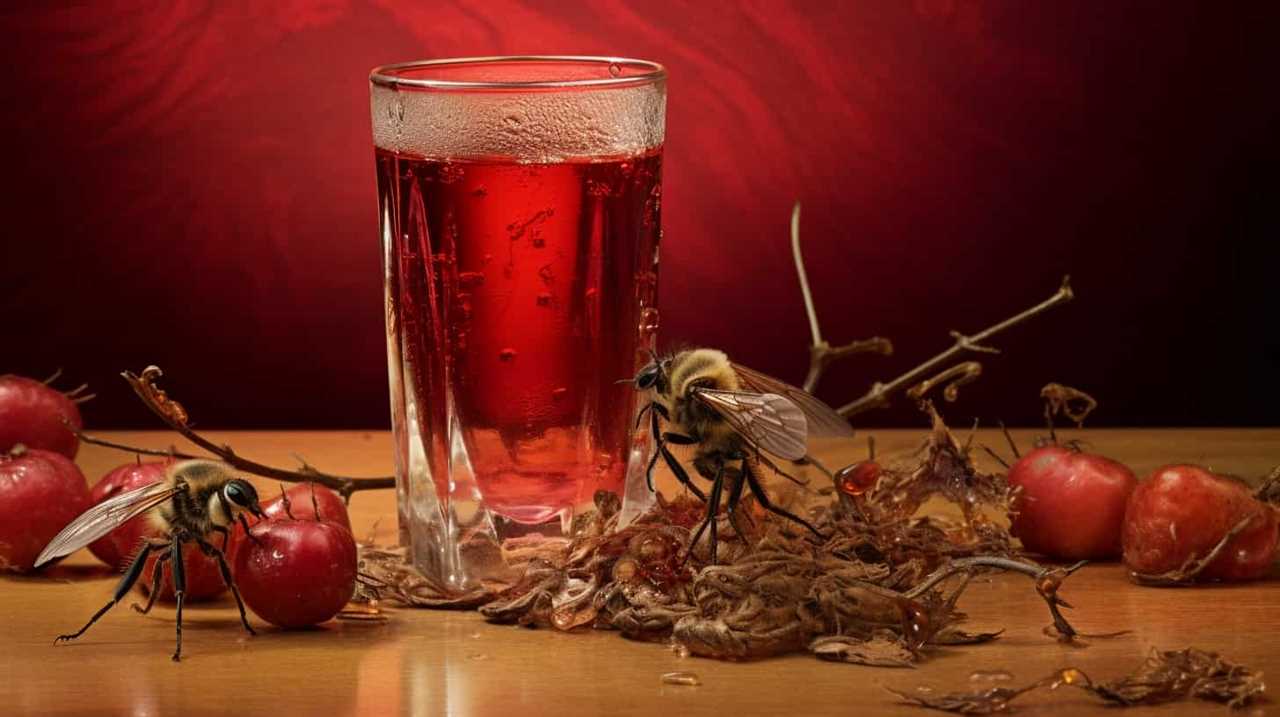
Now that we’ve mixed the lemonade concentrate, it’s time to adjust the sweetness and tartness to taste.
Adjusting the Sweetness and Tartness to Taste
We can adjust the sweetness and tartness of the lemonade to taste by adding more sugar or lemon juice, respectively. If you prefer a sweeter lemonade, simply add more sugar and stir until it dissolves completely. You can experiment with different sweeteners such as honey or agave syrup to find the perfect balance of sweetness.
On the other hand, if you want a tangier lemonade, add more lemon juice gradually, tasting as you go until it reaches your desired level of tartness.
Additionally, you can get creative with your lemonade by adding flavors like fresh mint leaves or a hint of lavender. These additions can elevate the flavor profile and create a more refreshing and unique experience.
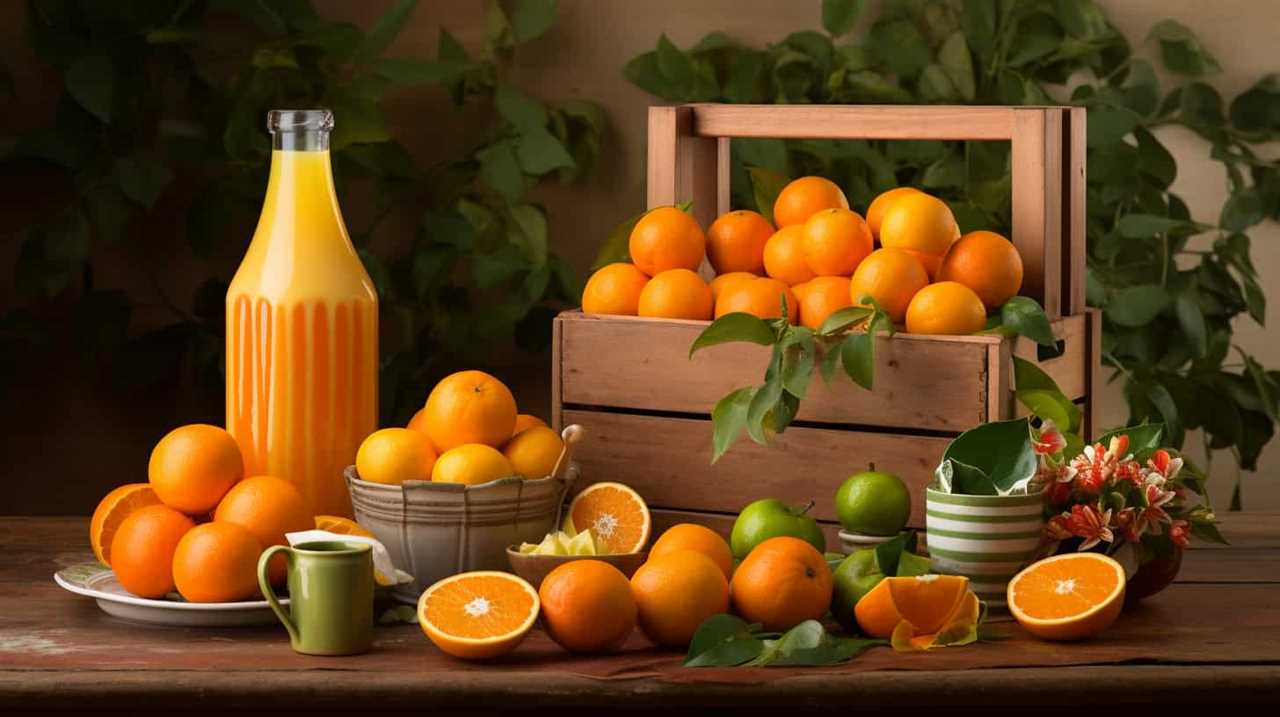
Now that we’ve adjusted the sweetness and tartness of our lemonade, let’s move on to serving and enjoying your refreshing glass of lemonade.
Serving and Enjoying Your Refreshing Glass of Lemonade
Now let’s sit back, relax, and savor our refreshing glass of lemonade.
When it comes to serving and enjoying this delightful drink, there are a few techniques and garnishing options to consider.
Firstly, serving your lemonade chilled is essential for maximum enjoyment. Ensure that you have chilled glasses or add ice cubes to the glasses before pouring the lemonade.

To add a touch of elegance, you can garnish your lemonade with a slice of lemon on the rim of the glass. For an extra burst of flavor, you could also add a sprig of fresh mint or a few berries.
Remember to gently stir the lemonade before serving to evenly distribute the flavors.
Now, take a sip, feel the refreshing tang of lemon, and let the sweet and tart flavors dance on your taste buds.
Cheers!
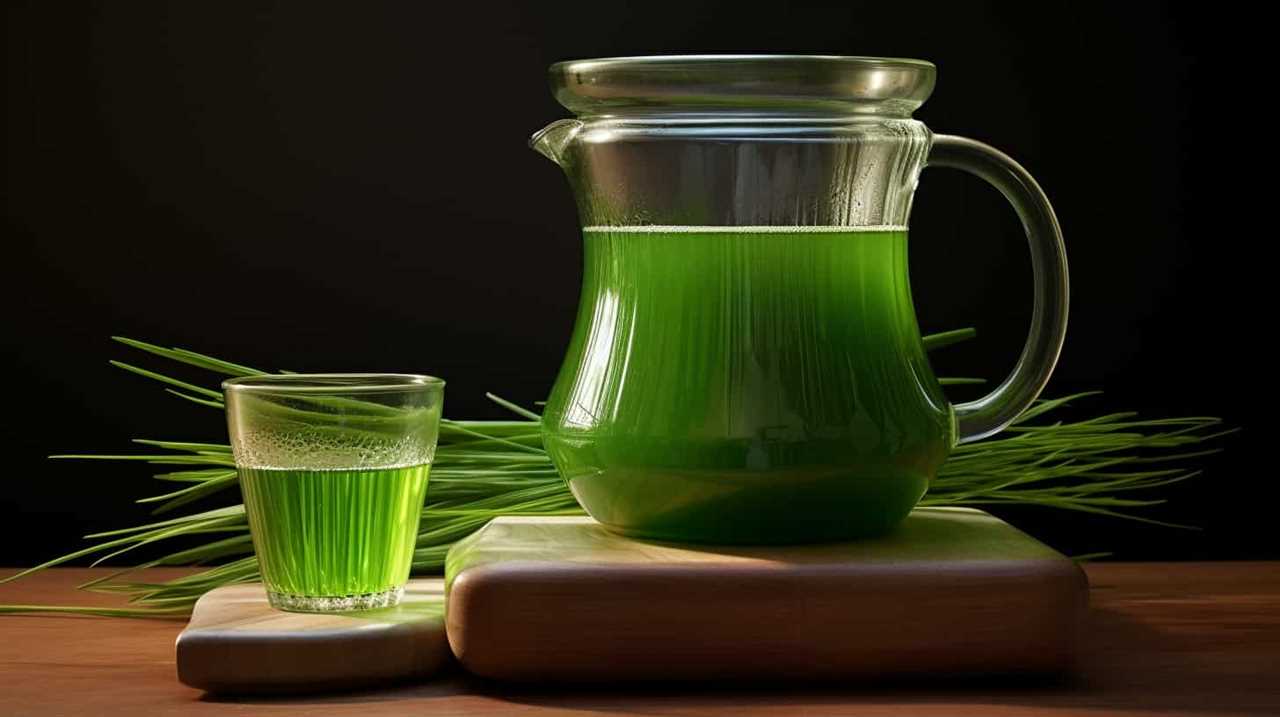
Frequently Asked Questions
Can I Use Fresh Lemons Instead of Bottled Lemon Juice?
Fresh lemons offer numerous benefits over bottled lemon juice. The taste of fresh lemons is unparalleled, providing a vibrant and tangy flavor. Incorporating fresh lemons into your lemonade will elevate its taste and give it a refreshing and authentic twist.
Can I Substitute Sugar With a Different Sweetener?
Substituting sweeteners in lemonade can enhance the flavor and offer health benefits. We’re knowledgeable about alternative sweeteners and can provide precise, detailed instructions on using them in place of sugar.
How Long Does the Lemonade Concentrate Need to Chill in the Refrigerator?
The chilling time for the lemonade concentrate in the refrigerator is typically around 1-2 hours. Using bottled lemon juice offers the benefit of convenience and consistent flavor for a refreshing glass of lemonade.
Can I Add Other Fruits or Flavors to the Lemonade?
Sure, we can definitely add different fruits or flavors to our lemonade. It’s a great way to experiment with unique flavors and create refreshing, personalized drinks. The possibilities are endless!

How Long Does the Lemonade Stay Fresh in the Refrigerator?
Lemonade made with bottled lemon juice can stay fresh in the refrigerator for about 5-7 days. To maximize shelf life, store it in an airtight container and keep it chilled.
Conclusion
And so, with a few simple steps and the right ingredients, a glass of refreshing lemonade is born.
Like a symphony of flavors dancing on your taste buds, this tangy elixir quenches thirst and brings joy on a hot summer day.
Just a sip transports you to a world of citrusy delight, where the sweetness and tartness blend harmoniously.

So go ahead, indulge in the art of lemonade-making and savor every drop of this sun-kissed nectar.
Cheers to the perfect glass of lemonade!
Susannah expertise lies in researching and compiling evidence-based content on juicing, nutrition, and overall health. She is committed to ensuring that The Juicery World offers accurate, up-to-date, and trustworthy information to empower readers to take control of their health. Susannah’s goal is to inspire individuals to embrace juicing as a way to nourish their bodies and live their best lives.
Juice Tips and Tricks
How to Know if Orange Juice Is Bad

We’ve all been in that situation before – reaching for a glass of orange juice and hesitating, unsure if it’s still okay to drink. Fear not! This article will give you the knowledge you need to determine for sure if your orange juice is still fresh or if it’s gone bad.
With a blend of scientific precision and practical tips, we’ll explore color changes, strange smells, off taste, texture changes, and mold or growth that may indicate spoilage.
Let’s dive in and serve ourselves a refreshing glass of certainty!
Key Takeaways
- Color changes in orange juice can indicate a loss of freshness and shelf life extension, but it doesn’t necessarily mean the juice is bad.
- Unusual or off-putting odors in orange juice, such as sour or fermented scents, can be a sign of poor quality.
- An off taste in orange juice, such as sour, bitter, or fermented flavors, suggests that the juice is spoiled.
- Texture changes in orange juice, such as pulp separation or a thicker consistency, can occur as the juice ages, so it’s important to consume it before the expiration date.
Color Changes in Orange Juice
We should be aware that color changes can indicate whether orange juice is bad.

When it comes to orange juice, color is a crucial factor to consider. As oranges are exposed to air, an oxidation process occurs, which leads to changes in color. Fresh orange juice has a vibrant orange hue, indicating its freshness and high nutritional value.
However, as time passes, the juice may undergo a color change, turning dull or brownish. This change in color is a result of the oxidation process, which affects the flavor and quality of the juice. It’s important to note that while a change in color doesn’t necessarily mean the juice is bad, it does indicate that the juice is losing its freshness and shelf life extension.
Therefore, it’s advisable to consume orange juice when it’s at its freshest, as indicated by its vibrant orange color.
Strange Smells in Orange Juice
When it comes to evaluating orange juice, we should be cautious of any strange smells or odors. A fresh, pleasant smell is indicative of good quality orange juice. However, if you notice any unusual or off-putting odors, it may be a sign that the juice has gone bad. These smells can range from a sour or fermented scent to a rancid or moldy aroma.

It’s important to note that while some natural variations in scent can occur due to the specific variety of oranges used, any strong or unpleasant smells should raise concerns. If you have citrus fruit allergies, it’s especially important to pay attention to the smell of orange juice, as it could indicate the presence of spoilage or contamination.
Ensuring the quality of orange juice is essential as it’s a popular beverage known for its health benefits, including being rich in vitamin C and antioxidants.
Off Taste of Orange Juice
Our taste buds can detect even the slightest hint of an off taste in orange juice, which can indicate that it has gone bad. The taste of orange juice should be fresh, tangy, and slightly sweet. If it tastes sour, bitter, or fermented, it’s likely spoiled.
One common cause of an off taste in orange juice is the use of overripe oranges. When oranges become overripe, their flavor profile changes, resulting in a less pleasant taste. Another factor to consider is the expiration date. Orange juice that has passed its expiration date is more likely to develop an off taste. It’s important to check the expiration date before consuming orange juice to ensure its freshness and quality.
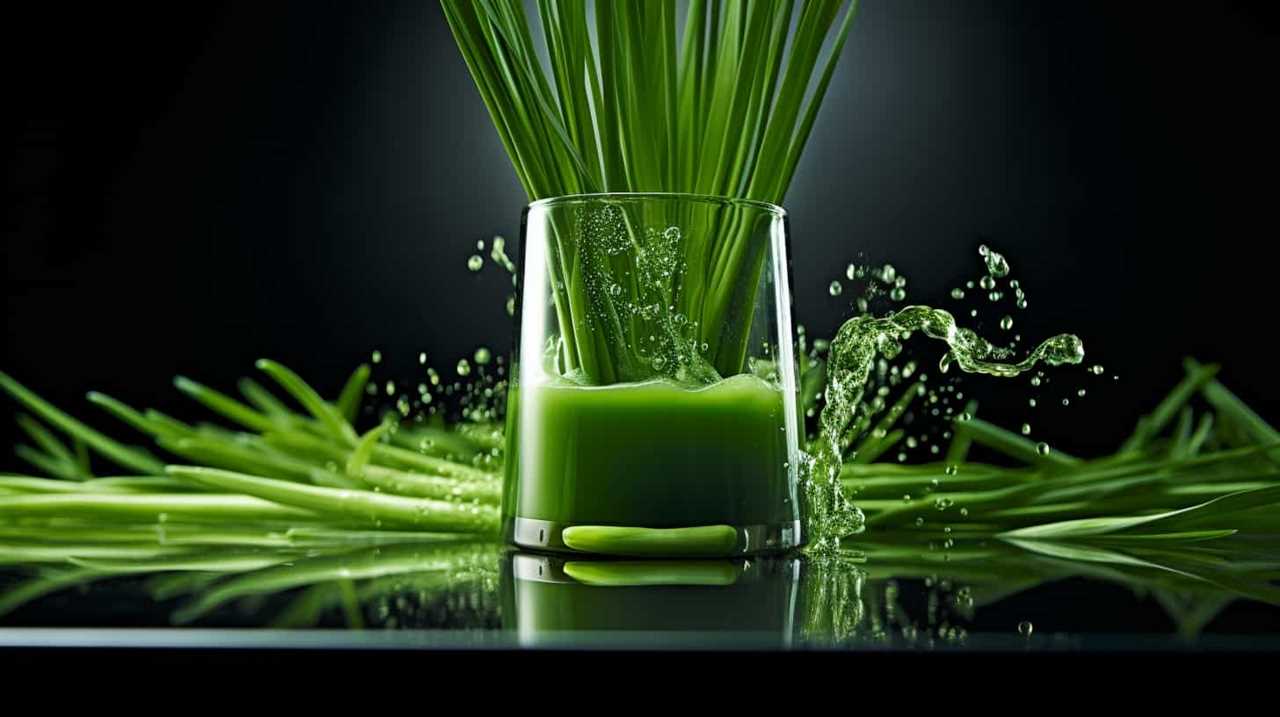
Now, let’s move on to discuss the texture changes in orange juice.
Texture Changes in Orange Juice
As we explore the texture changes in orange juice, it’s important to note that certain factors can cause it to become thicker or develop sediment. One common texture change in orange juice is pulp separation, where the pulp separates from the liquid and settles at the bottom. This can occur naturally over time, as the pulp particles become denser and sink.
Another factor that can affect the texture of orange juice is the expiration date. As orange juice ages, it may start to develop a thicker consistency and even form sediment. This is a result of the natural breakdown of the juice’s components. Therefore, it’s crucial to check the expiration date on orange juice and consume it before it reaches its expiration date to avoid any undesirable texture changes.
Mold or Growth in Orange Juice
We need to be aware of the possibility of mold or other growth occurring in orange juice. Mold can develop in orange juice if it isn’t stored properly or if it has passed its expiration date.
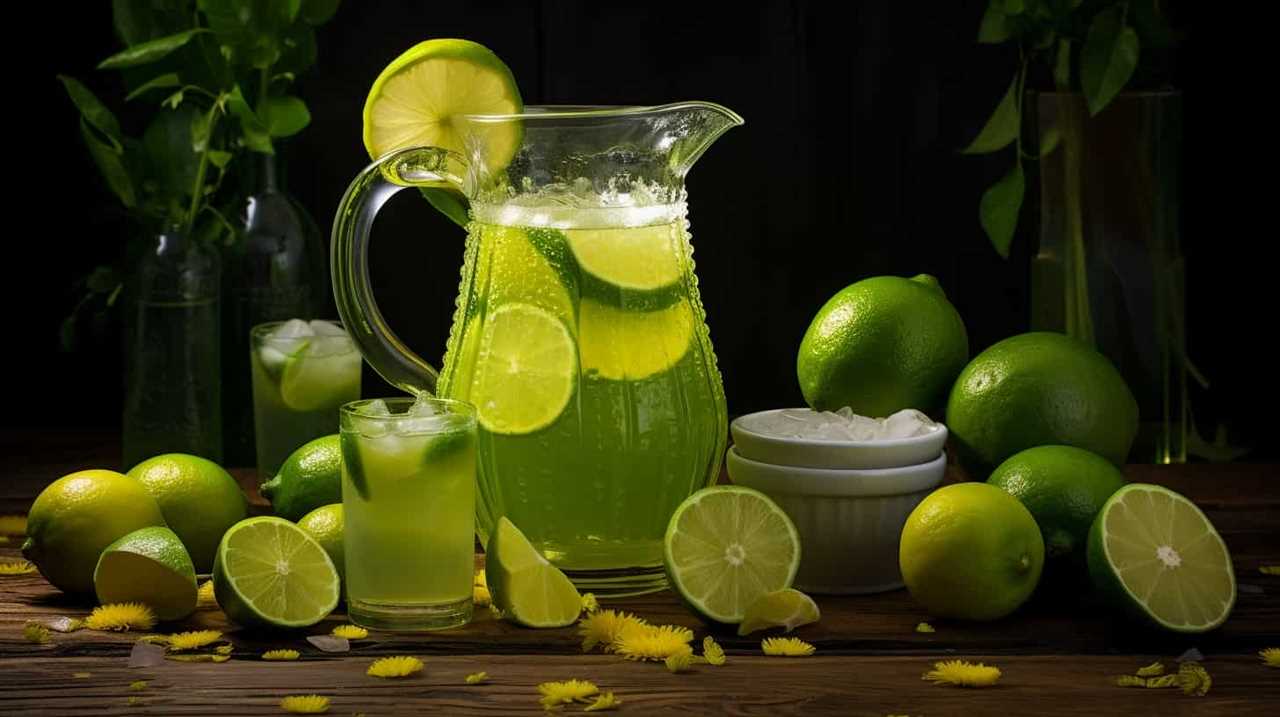
To prevent mold growth, it’s important to follow these steps:
- Store orange juice in the refrigerator at a temperature below 40°F (4°C).
- Check the expiration date on the bottle before consuming. Discard any orange juice that has expired.
- Keep the container tightly sealed to prevent air and moisture from entering, as these can promote mold growth.
Regularly inspecting orange juice for any signs of mold or unusual growth is essential. If you notice any discoloration, a strange odor, or visible mold, it’s best to discard the juice to avoid any potential health risks.
Frequently Asked Questions
Can Orange Juice Go Bad if It’s Stored in the Freezer for Too Long?
Frozen orange juice can potentially lose its nutrients and change its taste if stored in the freezer for too long. It is important to check for signs of spoilage before consuming it.
How Long Can Orange Juice Stay Fresh in the Refrigerator Once It’s Opened?
Once opened, orange juice can stay fresh in the refrigerator for about 7-10 days. To maintain its freshness, store it properly by keeping it tightly sealed and at a consistently cold temperature.
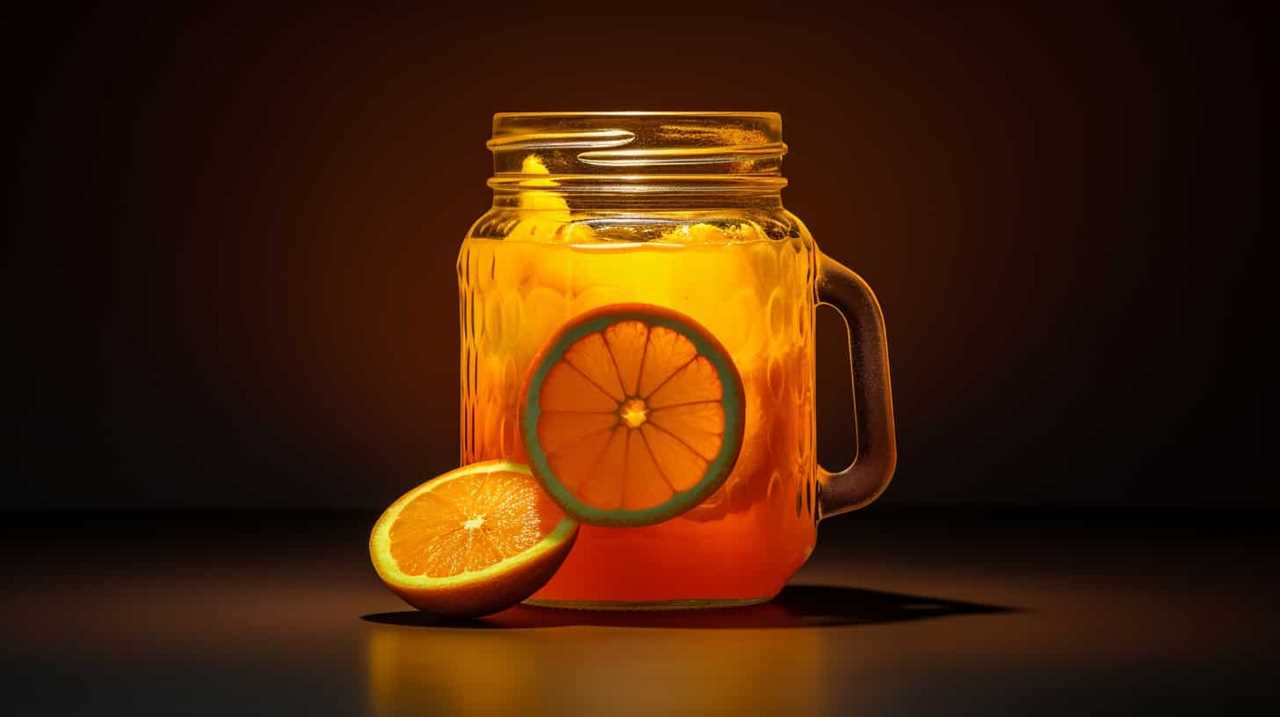
Is It Safe to Consume Orange Juice That Has Been Left Out at Room Temperature Overnight?
Left out orange juice may not be safe to drink as it can harbor harmful bacteria. Signs of spoiled orange juice include a sour smell, mold growth, and a change in color or taste.
Can Orange Juice Develop Harmful Bacteria if It’s Past Its Expiration Date but Still Looks and Smells Fine?
Orange juice can cause food poisoning if it develops harmful bacteria, even if it looks and smells fine. Signs of spoiled orange juice include a sour smell, mold growth, and a change in color or taste.
Does the Nutritional Value of Orange Juice Decrease as It Starts to Go Bad?
As orange juice goes bad, its nutritional value decreases. The longer it sits on the shelf, the more nutrients it loses. Signs of spoilage include a sour smell, off taste, and mold growth.
Conclusion
In conclusion, determining if orange juice is bad requires careful observation of color changes, strange smells, off taste, and texture changes. Just like a detective investigating a case, we must rely on our senses to detect any signs of spoilage.
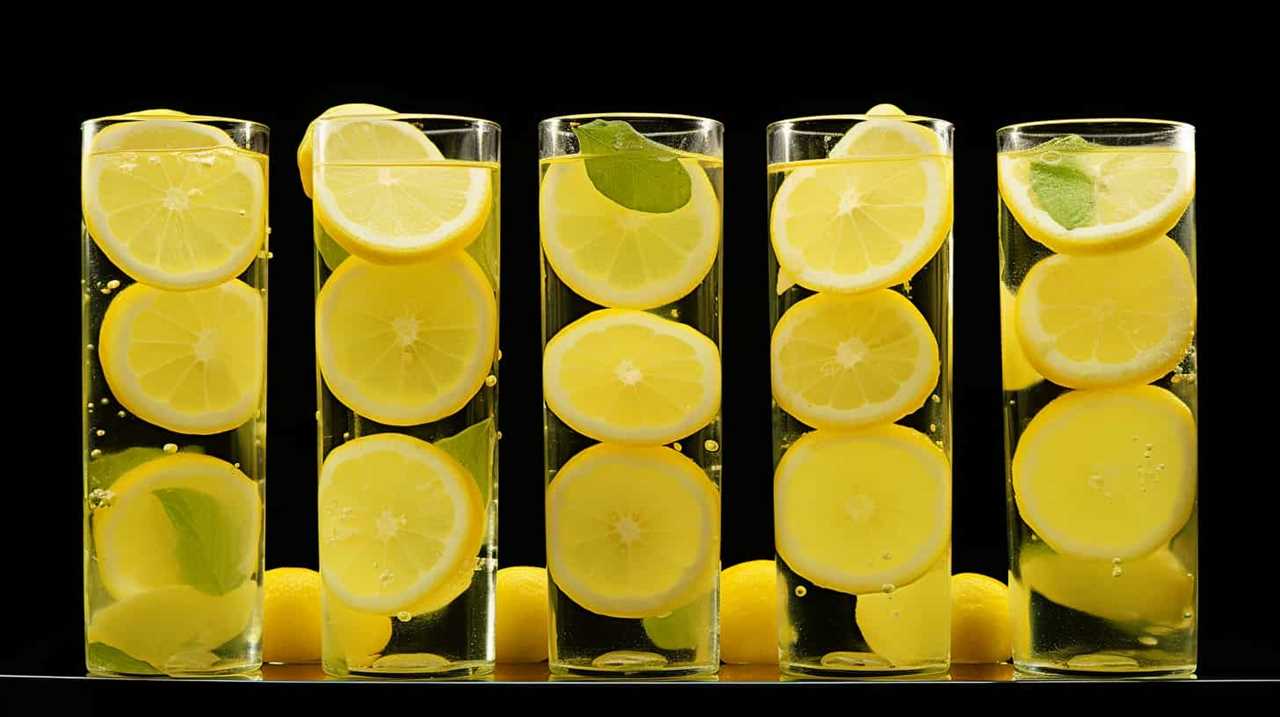
If we detect mold or growth in the orange juice, it’s a clear indication that it’s no longer safe to consume. By remaining vigilant and attuned to these indicators, we can ensure that our orange juice is always fresh and enjoyable.
Susannah expertise lies in researching and compiling evidence-based content on juicing, nutrition, and overall health. She is committed to ensuring that The Juicery World offers accurate, up-to-date, and trustworthy information to empower readers to take control of their health. Susannah’s goal is to inspire individuals to embrace juicing as a way to nourish their bodies and live their best lives.
-

 Juice Tips and Tricks3 months ago
Juice Tips and Tricks3 months agoHow Much Lemon Juice Is Equal To Half A Lemon
-

 Juice Tips and Tricks3 months ago
Juice Tips and Tricks3 months agoHow Long Can You Drink Orange Juice After The Expiration Date
-

 Fruit Juice Varieties3 months ago
Fruit Juice Varieties3 months agoTop 11 Most Loved Fruit Juice Varieties
-

 Juice Tips and Tricks3 months ago
Juice Tips and Tricks3 months agoHow Much Lemon Juice Is Equivalent To 1 Lemon
-

 Organic and Natural Juices2 months ago
Organic and Natural Juices2 months ago8 Best Organic Brands for Fruit Juice
-

 Juice Tips and Tricks3 months ago
Juice Tips and Tricks3 months agoHow Much Lemon Juice Is Equivalent To One Lemon
-

 Juice Manufacturing Process2 months ago
Juice Manufacturing Process2 months ago9 Best Steps in Industrial Juice Manufacturing Process
-
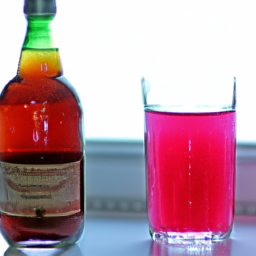
 Juice Tips and Tricks3 months ago
Juice Tips and Tricks3 months agoHow Long Does Cranberry Juice Last After Expiration Date



